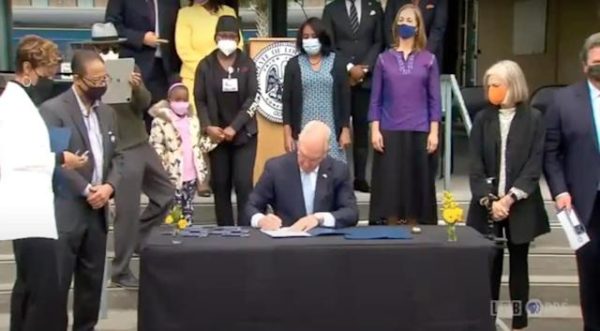After 125 years, the Louisiana governor posthumously pardoned Homer Plessy, the central character in the 1896 case Plessy vs. Ferguson which was the foundation of America’s system of “separate but equal.”
The state Board of Pardons recommended last November that Plessy be pardoned.
After accepting the recommendation, Gov. John Bel Edwards said at a ceremony announcing his decision that he was “beyond grateful” for the opportunity to affirm Plessy’s “legacy of the rightness of his cause … undefiled by the wrongness of his conviction.”

The cause that reflects the then 30-year-old’s legacy of rightness was racial equity. NOLA reports that on June 7, 1892, the New Orleans shoemaker, as a member of the activist group called the Citizens Committee (Comité des Citoyens), purchased a first-class ticket and boarded a whites-only rail car to engage in an act of civil disobedience in protest of the state law that segregated trains.
He was selected because he was said to be a man of mixed race heritage (7/8 white and 1/8 Black). Keith Weldon Medley noted in his book, “We As Freemen: Plessy v. Ferguson,” that though he was not as accomplished as others in the group, his fair complexion was an asset to the cause.
He wrote, “His one attribute was being white enough to gain access to the train and black enough to be arrested for doing so.”
The committee hired a private detective with arresting powers to follow Plessy and arrest him when he got off the train at Press and Royal streets. They purposefully got him arrested to ensure that he was charged with violating the state’s separate-car law.
Out of this action, the Supreme Court launched one of the nation’s most historic and controversial cases known as Plessy v. Ferguson, and ruled that identifying spaces as white-only and colored-only was legal. This sanctioned the practice of Jim Crow in schools, hotels, modalities of transportation, and other public facilities.
Cornell Law’s Legal Information Institute notes that Plessy was prosecuted in the State of Louisiana for refusing to leave a passenger car designated for whites. Justice Henry Billings Brown of the Supreme Court wrote in an opinion piece that the Fourteenth Amendment of the Constitution, though created to enforce the political equality of Blacks and whites, was not intended to abolish social inequality or discrimination.
Justice John Marshall Harlan was the sole dissenting voice and said that he believed the opposite, interpreting the amendment as a tool for racial equality and equity. He wrote, “In view of the Constitution, in the eyes of the law, there is in this country no superior, dominant, ruling class of citizens.”
“There is no caste here. Our constitution is color-blind, and neither knows nor tolerates classes among citizens. In respect of civil rights, all citizens are equal before the law,” the Kentucky native argued. “The humblest is the peer of the most powerful. The law regards man as man, and takes no account of his surroundings or of his color when his civil rights as guaranteed by the supreme law of the land are involved….”
In 1954, Plessy v. Ferguson was overturned by Brown v. Board of Education of Topeka, where the Supreme Court ruled that separate accommodations based on race were, in fact, unequal and therefore unconstitutional.
Plessy died in 1925 with this conviction still on his record.
Phoebe Ferguson, a descendant of New Orleans jurist John H. Ferguson, the judge that ruled against Plessy, said, “This doesn’t erase the wrong. We can’t undo the wrongs of the past, but we can learn from them and keep them from happening in the future.”
One relative who attended the ceremony was Keith Plessy and he said it was “truly a blessed day for our ancestors … and for children not yet born.” His great-great-grandfather was Plessy’s cousin.
He said to the USA Today Network, “I just feel gratitude for my ancestor who stood up and set an example for generations of civil rights activists who would follow him.”
“Sometimes I don’t feel like my feet are on the ground because my ancestors are carrying me,” he said. “I’m holding back tears because I’m too happy to cry.”
Both Keith Plessy and Phoebe Ferguson have worked together to restore Homer Plessy’s legacy and in 2009 unveiled a plaque at the former site of the Press Street Railroad Yards to honestly tell the stories of both of their ancestors.
More news from our partners:


